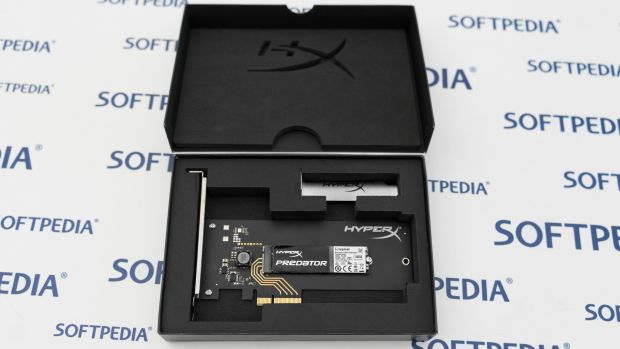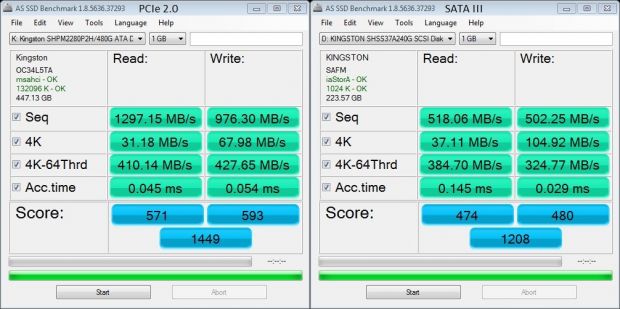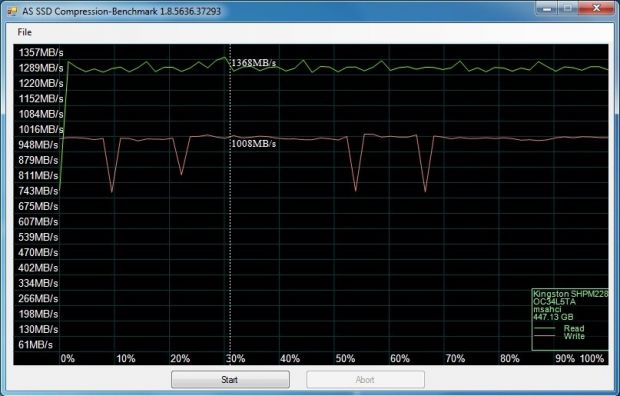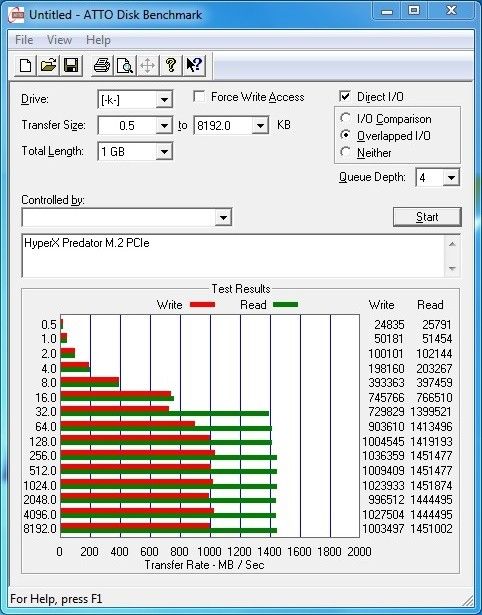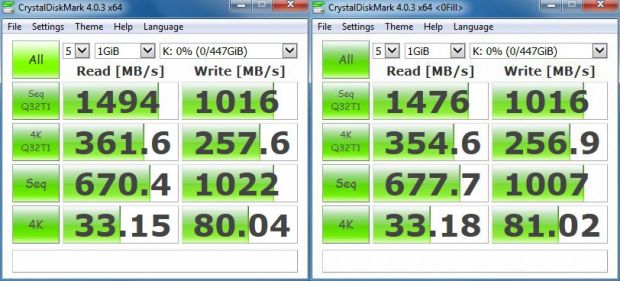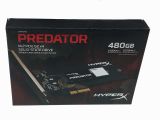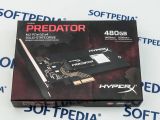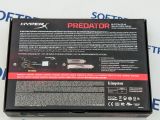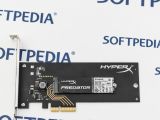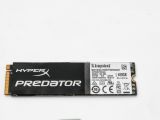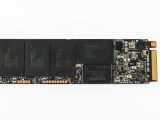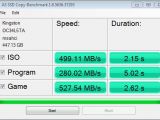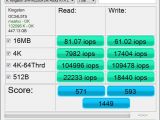When we think about storage devices, the most common and readily available product we find on the market is the classical SATA HDD with circular spinning platters of various capacities ranging from 250GB to even 1TB that offer modest but acceptable sequential transfer rates and focus on sheer data space available instead of speed.
Disk size is and will always be an issue to be taken into consideration when buying a new storage device, be it a SATA SSD, a SATA HDD or one of the newer PCIe SSDs. Regardless, most clients and usage scenarios will benefit the most from a compromise between speed and storage space, and only specific use cases will require favoring one of the two.
However, when thinking about speed, and only speed, there's nothing out there faster than PCI Express 2.0/3.0 SSDs.
In this highly exclusive race, two industry leaders lead the small pack of PCIe SSD manufacturers: Intel and Samsung.
Intel takes the crown with the highly efficient PC3000 series that offers mind boggling 2,800 MB/s read and 2,000 MB/s write speeds and capacities ranging from 400 GB to 2 TB. Samsung offers serious competition with its business-oriented XS1715 SSD using a PCIe 3.0 interface for a 1.6 TB NVMe drive with even higher read/write speeds of 3000/1400 MBs and low latency, all in a 2.5" form factor.
These are, however, dedicated to high-performance business applications like servers and data centers and come at extreme prices of well over $1,000. When it comes to Samsung, M.2 and 2.5" form factor SSDs are sold separately and come with wildly different specs and prices, never in one package with convenient adapters.
| Product | HyperX Predator 480 GB PCIe |
|---|---|
| Form Factor | PCIe Adapter PCIe 2.0 x4 |
| Controller | Marvell 88SS9293 |
| Flash | Toshiba A19 MLC |
| DRAM | Kingston Branded |
| Sequential Read / Write | 1,400 / 1,000 MB/s |
| Random Read / Write | 130,000 / 118,000 IOPS |
| Endurance | 1.7 DWPD |
| Warranty | 3 Years |
The HyperX Predator uses a PCIe 2.0 connector and works perfectly in any PCIe 3.0 slot without any performance impact, unlike the PCIe SSDs from Intel and Samsung will lose performance when connected to mini ITXs equipped with PCIe 2.0.
Enthusiasts will highly appreciate this high-speed storage interconnect, and newer models of laptops have started to adopt the new M.2 PCIe, ruling out the former 2.5" bays, but unfortunately for extreme prices more often than to.
The fact that Kingston's M.2 SSD is also bootable on quite a number of motherboards means that it has a major advantage against its main rivals where such a feat is still to be desired.
The Benchmark Testing System
| Motherboard | Asus Rampage IV Extreme X79 chipset) |
|---|---|
| CPU | Intel Core i7 3820 @ 3.60GHz Sandy Bridge-E 32nm Technology |
| RAM | Kingston Hyper X 8.00GB DDR3 @ 667MHz (9-9-9-24) |
| OS | Windows 7 64-bit Service Pack 1 |
Packaging
The 480GB SSD we received came in a nice, light box carrying an HHHL desktop adapter, with two Brackets, one full height and the other half-height. The half-height one is highly useful as it turns the SSD into a low profile card, which can allow for installation of the SSD in slim cases as well as 1RU server cases, which would benefit the most from a large number of SSDs like this one. You can, however, ignore this feature and pay $10 less for a package that lacks the desktop adapter.
The sale package also includes a key for Acronis True Image HD, which is very handy for migrating existing data to the new drive, a Hyper X sticker and a warranty statement. The warranty will cover your SSD for a three-year period, while Kingston rates the device at 1.7 DWPD (Drive Writes per Day). Unlike its SATA SSD little brother, it's recommended not to exceed this write cycle, although it will not void your waranty.
Looking at the back of the M.2 card itself, we can see eight Toshiba A19 NAND flash drives and near the M.2 pins the Marvell logo is clearly visible to mark its well-known controller. Although lots of modules are present on the small PCB, the tight fit and careful packaging show Kingston's experience of manufacturing and delivering DRAM.
We tested Kingston's speedy PCIe SSD using benchmarking software like AS SSD, ATTO and Crystal Disk 4.0. On AS SSD, we tested its sequential read/write speed, access time, IOPS, 4K data transfer on both 32 and 64 threads. Compression speed followed next. Same tests were had on ATTO and Crystal Disk in order to give us enough data to help us set a common performance denominator.
AS SSD Benchmark 1.8.5636.36856
The AS-SSD benchmark tested the SSD in four situations, the Read/Write speeds on sequential and 4K together with access speeds, ISO emulation data transfer and data compression rates. We tested the HyperX on an X79 chipset, and the results were very impressive, especially the read/write speeds that show almost exactly the speeds advertised by Kingston.
Just for comparison, we also attached our previously reviewed Kingston HyperX Savage SATA SSD transfer speed on an X99 chipset. Needless to say, PCIe speeds are more than double.
We also discovered that the AS SSD was probably the most pessimistic of all our benchmarking software when showing the default speeds, as we'll show you later on.
IOPS showed , again, performance pretty close to the one advertised, more specific on the 4K-64 Thread.
Next up is data compression speed that is by no means disappointing. Usually, a straight line in such screens shows a stable performance, and as input/output performance speed is quite high, we can see that read/write sequential maintain an impressive constant in all tests showing again Kingston's advertised speeds.
The final AS SSD test consisted in testing the ISO emulation which, surprisingly, was fairly similar with our older SATA SSDs. ISO emulation work is almost identical with any other NAND flash drive as it tests a drive's ability to read and write at the same time.
Our AS SSD conclusion was that after making four consecutive tests with different option tweaks like disabling 4K and 4K-64 Thread and upgrading to 3GB for data transfer size, our stress case showed the same consistent and constant test results, the Predator losing no performance whatsoever during our extended test case.
ATTO Disk Benchmark v2.47
Being one of the older and well-regarded disks benchmarks, it's still very useful when testing SSD drives. ATTO will place the results in red/green horizontal lines that represent write/read in order to make interpretation of the benchmark results graph easy to understand. The test was done running a data transfer size of 0.5 to 8192 KB keeping the total length of 256MB.
It's worth seeing that ATTO shows much more positive write results than AS SSD giving us over 1,400 MB/s read speeds while keeping the read speed at a constant 1,000MB/s, and sometimes even slightly above that. ATTO clearly does Kingston a "favor" as the numbers showed are very much spot on.
Crystal Disk Mark 4.0.3a x64
Crystal Disk is a handy benchmark utility that helps in rapid measurements of sequential and random read/write speeds. CrystalDisk can test through Native Command Queuing of 32. NCQ, however, supports mainly by SATA controllers. Errors for testing PCIe connectors with a PCIe 2.0 controller are very much possible. However, results didn't vary that much from the previous ones so we tend to take Crystal Disk's results as being fairly accurate.
Conclusion
This flexibility is also reflected in the accessories, and providing an M.2 adapter it allows the user to connect it either to a very high-speed PCIe port or to an even faster M.2 port, basically letting the user choose between high data transfer speed and very high data transfer speed.
Being bootable is also an incredible addition that makes the drive stand out in front of its competition. The included Acronis True Image license gives access to a reliable disk cloning utility that transfers the data from your existing drive to the HyperX SSD.
After using the software, you simply tell the BIOS to boot from the Kingston SSD and everything works as it should. It's all about simplicity, and even though the data synchronization will take some time, it won't take that long given its impressive transfer speeds, and everything is done automatically without any hassle.
Nonetheless, warranty remains an issue as Samsung's premium SSDs can go up to 10 years, while Kingston insists on keeping its device on a 3-year warranty limit while rating it for 1.7 drive writes/day. Not a big deal for some, nor Kingston writes this rule in stone, but it's worth remembering that the HyperX Savage came with a warranty that allowed unlimited write operations per day.
All in all, this is an excellent product, a pure breed SSD built for performance and speed, and more than that, it appears to be a benchmarkers’ dream as no stat disappointed us when we put it through its paces.
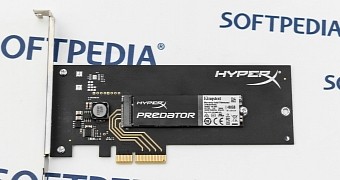
 14 DAY TRIAL //
14 DAY TRIAL // 